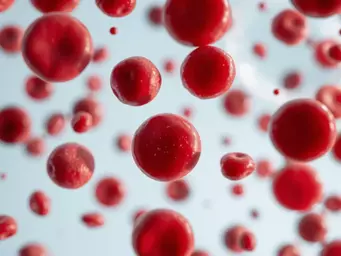Annual New Cases in US
diagnosed each year
CLL is one of the most common leukemias among adults, emphasizing the need for awareness.
Did you know that approximately 21,000 new cases of Chronic Lymphocytic Leukemia (CLL) are diagnosed each year in the United States? This statistic highlights the importance of increasing awareness and understanding of this condition.
Chronic Lymphocytic Leukemia (CLL) is a prevalent cancer with specific demographic patterns. The visual below highlights key statistics regarding its occurrence and patient profile.
diagnosed each year
CLL is one of the most common leukemias among adults, emphasizing the need for awareness.
years old
CLL primarily affects older adults, highlighting age as a significant demographic factor.
of all leukemia cases
CLL is more frequent in men, accounting for a substantial portion of their leukemia diagnoses.
of all adult leukemia cases
Chronic Lymphocytic Leukemia represents a significant proportion of all leukemia diagnoses.
Chronic Lymphocytic Leukemia, commonly referred to as CLL, is a type of cancer that primarily affects the blood and bone marrow. In CLL, the body produces an excess of abnormal lymphocytes—a type of white blood cell—that can crowd out healthy cells, leading to a variety of complications. This can create a major impact on the body's ability to fight infections and maintain overall health. Understanding CLL is crucial for patients and families as it provides an opportunity to navigate the diagnosis and treatment options more effectively.
At What Is Leukemia, we strive to shed light on this condition, empowering individuals with knowledge and hope. By learning more about what CLL is, we can pave the way for better conversations with healthcare providers and informed decisions about treatment.
CLL is characterized by the slow accumulation of B-cell lymphocytes in the blood, bone marrow, and lymph nodes. As these abnormal cells grow, they can interfere with the production of normal blood cells, which may lead to symptoms like anemia and increased susceptibility to infections. Most notably, CLL is a chronic disease, meaning it typically progresses more slowly than acute leukemias, often allowing patients to live for many years with the disease. This distinction is important as it allows for a more measured approach to treatment. Many patients may not require immediate intervention and can be monitored over time—a practice known as "watchful waiting."
Statistics show that CLL is one of the most common types of leukemia among adults, representing about 25% of all leukemia cases. According to current research, it is estimated that approximately 21,000 new cases of CLL are diagnosed each year in the United States alone, with the average age at diagnosis being around 70 years. It occurs more frequently in men than in women, with a ratio of about 2:1. For further details on CLL prevalence and characteristics, you can refer to resources from the American Cancer Society.
Recognizing the symptoms of CLL is essential for early detection and management. Common symptoms may include:
If you're experiencing any of these symptoms, it's vital to consult your healthcare provider. Early recognition can lead to better outcomes!
In addition to the common symptoms mentioned, there are specific warning signs that should prompt immediate medical advice:
Listening to your body is crucial. If you notice anything unusual, don't hesitate to reach out to your doctor. Your health and peace of mind are important!
Research indicates that certain genetic mutations can predispose individuals to develop CLL. Family history plays a significant role; if you have a relative diagnosed with CLL, your risk may be higher than the general population. Understanding these inherited factors can help assess your personal risk and guide preventive measures. At What Is Leukemia, we encourage families to have conversations about health histories, as this can lead to earlier screenings and interventions.
Some studies suggest that exposure to certain environmental factors, such as Agent Orange, may increase the risk of developing CLL. Other potential risks include exposure to pesticides, certain chemicals, and radiation. Awareness of these environmental influences can empower individuals to take proactive steps in minimizing risk factors.
CLL is more common in older adults, particularly those over the age of 60. Additionally, gender plays a role, as men are more likely than women to develop CLL. Family history is another critical factor; having a first-degree relative with CLL significantly increases one's risk. Understanding these demographic elements can help with early detection and personalized care strategies. More information on risk factors can be found on MedlinePlus.
CLL primarily affects B-cell lymphocytes, but there is a rare form known as T-cell CLL. The main difference lies in the type of lymphocyte affected. B-cell CLL is far more common and is what most discussions about CLL focus on. T-cell CLL, while less frequent, can present different symptoms and may require alternative treatment approaches. Understanding these distinctions is vital for tailoring a treatment plan that best suits the needs of the patient.
The type of CLL can significantly influence treatment outcomes. For instance, B-cell CLL often responds well to targeted therapies, whereas T-cell CLL may be more challenging to treat. Knowing the specific type of CLL can guide both patients and their healthcare teams in making informed decisions about the most effective therapies available.
Diagnosing CLL typically involves a combination of tests, including:
These diagnostic tools help healthcare providers determine the nature and extent of the disease, enabling personalized treatment plans.
Undergoing tests for CLL can be daunting, but knowing what to expect can alleviate some anxiety. Your doctor will likely explain the procedures clearly and may perform several tests to confirm a diagnosis. Each step is crucial in understanding your health status and planning the best course of action. Staying informed during this process can empower you to ask questions and engage actively with your healthcare team. Remember, you are not alone on this journey!
Advancements in treatment for CLL have brought about various options, including:
Understanding the differences between these therapies can help patients make informed decisions that align with their treatment goals. For comprehensive information on treatment options, the National Cancer Institute provides detailed guidance.
The field of CLL research is rapidly evolving, with new treatments and clinical trials emerging regularly. Staying informed about the latest advancements can open doors to innovative therapies that may improve outcomes. Discussing potential participation in clinical trials with your healthcare provider can be a valuable step in exploring all possible treatment avenues.
Living with CLL requires adjustments to daily life, but there are practical tips that can help:
These small changes can make a significant impact on your overall well-being as you navigate living with CLL.
A strong support system is crucial for individuals with CLL. Connecting with support groups can provide a sense of community and shared experience, while also offering access to valuable resources. Mental health is equally important; seeking counseling or therapy can help manage the emotional toll of a cancer diagnosis. At What Is Leukemia, we believe that informed patients are empowered patients. Surrounding yourself with a supportive network can help you face the challenges of CLL with greater resilience and hope!
Did you know? Engaging in regular discussions with your healthcare team about your treatment options can significantly enhance your understanding of CLL and empower you to make informed choices. Don't hesitate to ask questions; knowledge is a vital tool in your journey!
Understanding chronic lymphocytic leukemia (CLL) is not just about knowing the facts; it’s about recognizing the profound impact it can have on individuals and their families. Early awareness of CLL can significantly improve outcomes and enhance the quality of life for those affected. When we take the time to learn about CLL, we empower ourselves and others to navigate this complex journey with informed confidence.
Knowing the signs and symptoms of CLL can lead to earlier diagnosis, which is crucial for effective treatment. Research shows that patients who are diagnosed early often experience better prognoses. Therefore, staying informed, asking questions, and seeking medical advice when necessary are all vital steps in managing CLL.
How understanding CLL can lead to better outcomes and prognosis is straightforward: knowledge fosters proactive healthcare decisions. When patients and their families are aware of CLL's signs, symptoms, and potential treatments, they can advocate for themselves and play an active role in their healthcare journey.
As someone who has witnessed countless patients navigate their leukemia journey, I firmly believe that informed patients are empowered patients. This empowerment is not only about understanding medical terminology but also about fostering open conversations with healthcare teams and loved ones.
Sharing personal stories and experiences with CLL can create a sense of unity and strength among those affected. Support groups provide a platform for individuals to connect, share insights, and offer encouragement. These communities can help dispel feelings of isolation, reminding us that we are not alone on this journey.
Resources like these can be invaluable for patients and their families. They offer not only educational materials but also a lifeline to others who understand the challenges of living with CLL. At What Is Leukemia, we are committed to bridging the gap between complex medical information and patient understanding, helping to foster a supportive community that thrives on shared knowledge and compassion.
Here is a quick recap of the important points discussed in the article:



 When it comes to navigating health concerns like leukemia, knowledge is your greatest ally. Understa
When it comes to navigating health concerns like leukemia, knowledge is your greatest ally. Understa
 As we step into a new era of leukemia treatment, imagine the potential of groundbreaking therapies r
As we step into a new era of leukemia treatment, imagine the potential of groundbreaking therapies r
 In the intricate world of blood cell functions, understanding their roles not only illuminates our b
In the intricate world of blood cell functions, understanding their roles not only illuminates our b
 What if the key to managing leukemia lies not just in conventional treatments, but in a holistic app
What if the key to managing leukemia lies not just in conventional treatments, but in a holistic app